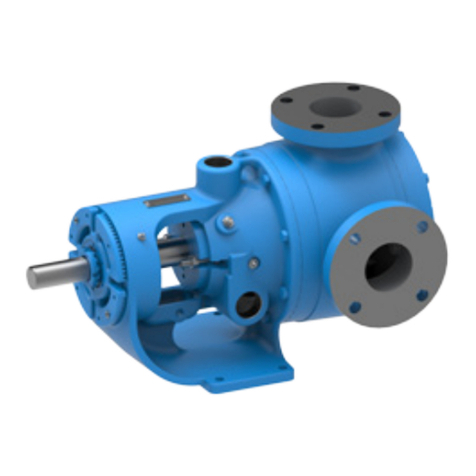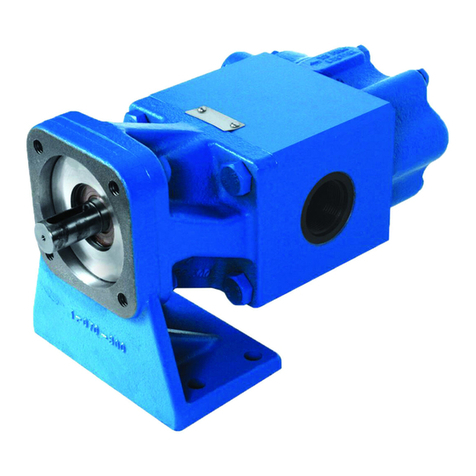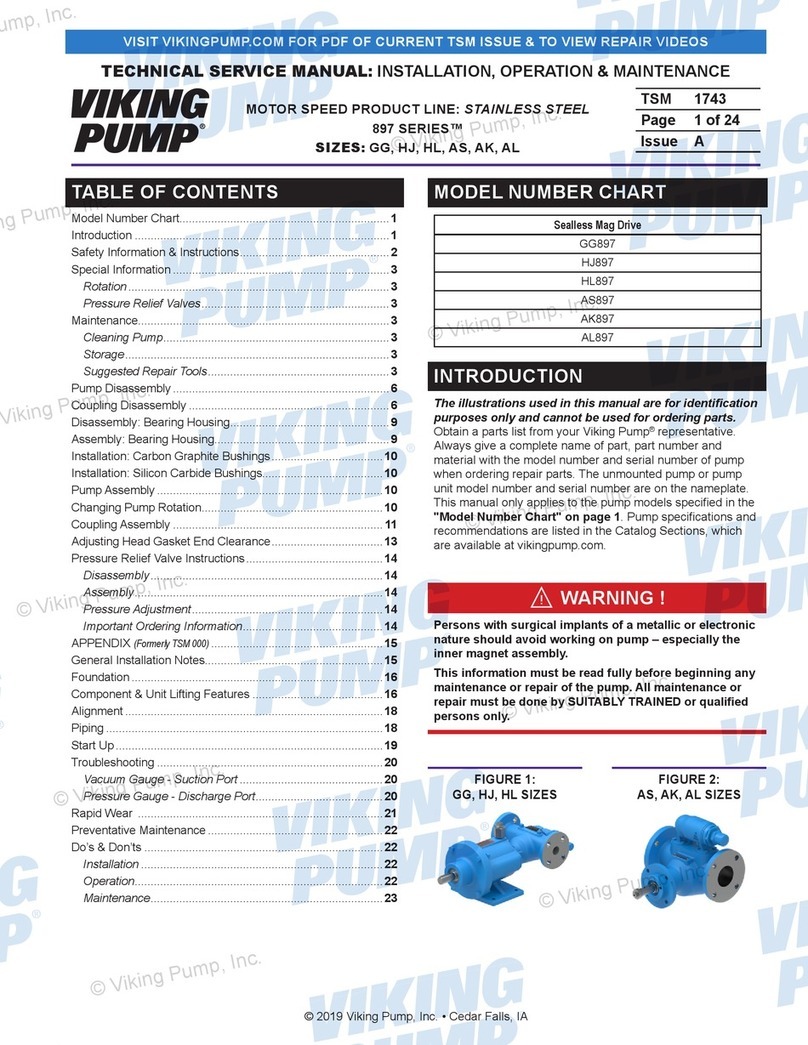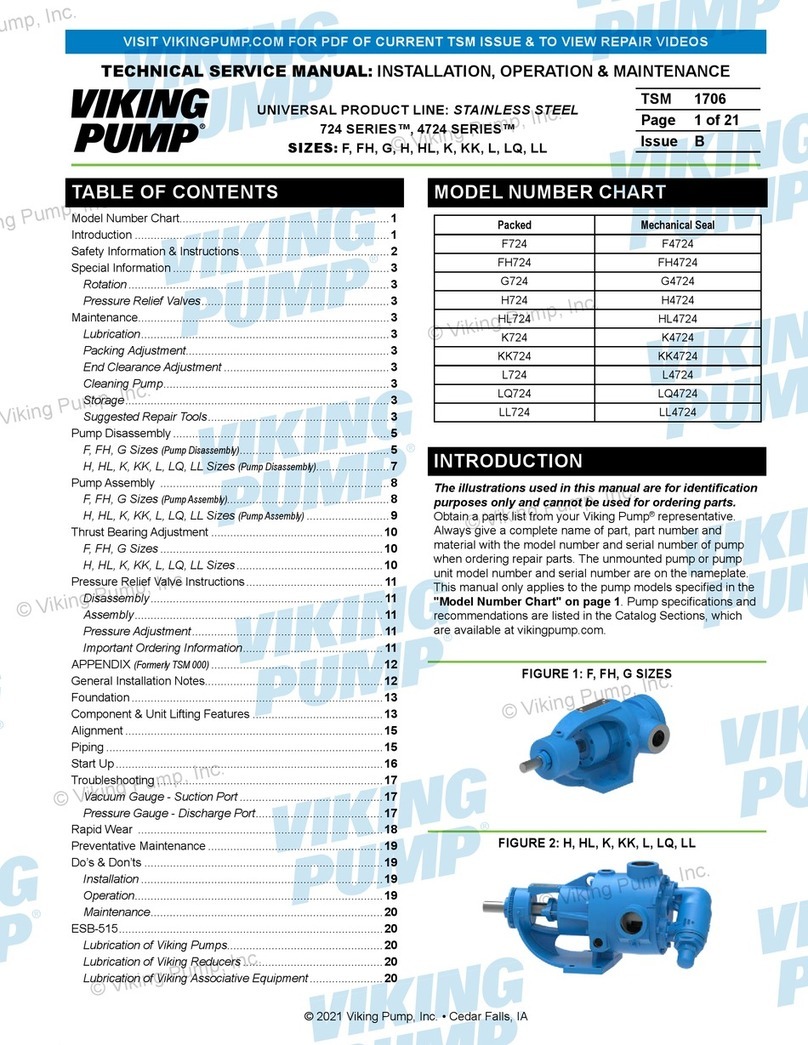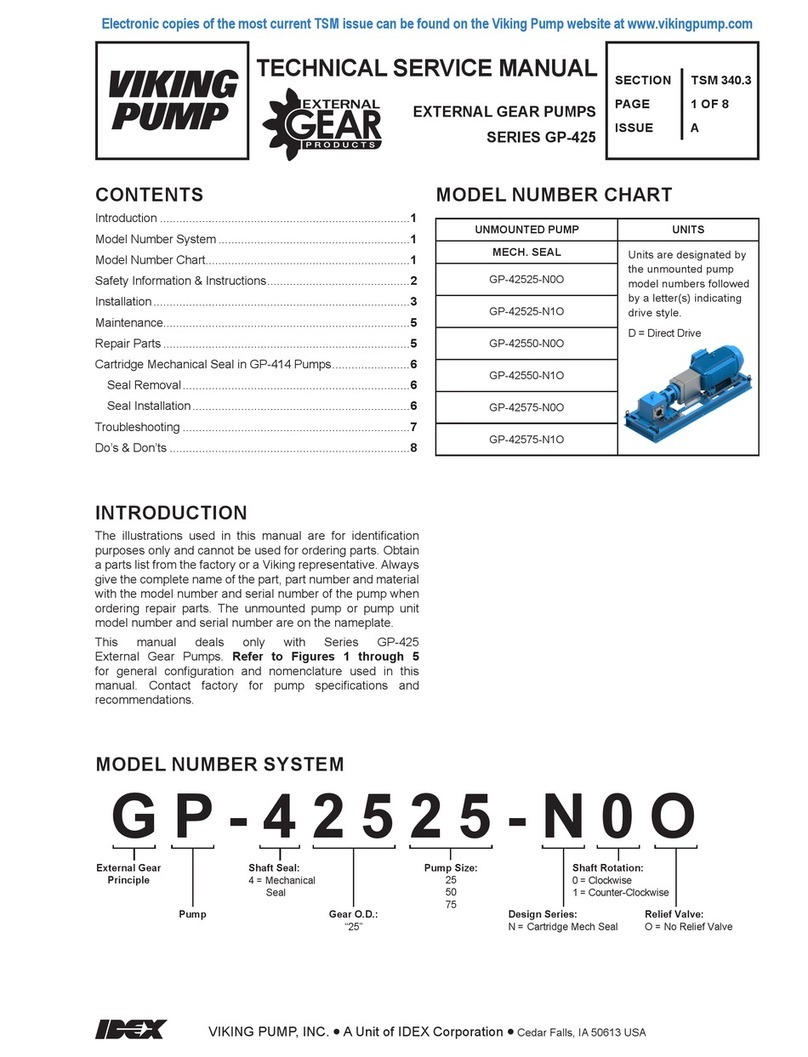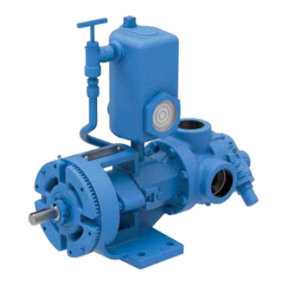
SECTION TSM 630 ISSUE J PAGE 3 OF 10
MAINTENANCESPECIAL INFORMATION
ROTATION: Viking pumps operate equally well in a
clockwise or counterclockwise rotation. Shaft rotation
determines which port is suction and which is discharge.
Port in area where pumping elements (gear teeth) come out
of mesh is suction port.
PRESSURE RELIEF VALVES:
1. Viking pumps are positive displacement pumps and
must be provided with some sort of pressure protection.
This may be a relief valve mounted directly on the pump,
an inline pressure relief valve, a torque limiting device or
a rupture disk.
2. There are relief valve options available on those pump
models designed to accept a relief valve. Options may
include a return to tank relief valve and a jacketed relief
valve. Pumps equipped with a jacketed head plate are
generally not available with a relief valve.
3. If pump rotation is reversed during operation, pressure
protection must be provided on both sides of pump.
4. Relief valve adjusting screw cap must always point
towards suction side of pump. If pump rotation is
reversed, remove pressure relief valve and turn end for
end.
5. Pressure relief valves cannot be used to control pump
flow or regulate discharge pressure.
For additional information on pressure relief valves, Refer
to Technical Service Manual TSM000 and Engineering
Service Bulletin ESB-31.
SPECIAL MECHANICAL SEALS:
Extra care should be taken in repair of these pumps. Be sure
to read and follow all special instructions supplied with your
pump.
Series 124A, 4124A, 126A, 4126A, 123A, 4123A, 127A, and
4127A pumps are designed for long, trouble-free service life
under a wide variety of application conditions with a minimum
of maintenance. The points listed below will help provide long
service life.
LUBRICATION:External lubrication must be applied slowly
with a hand gun to all lubrication fittings every 500 hours
of operation with multi-purpose grease, NLGI # 2. Refer to
Engineering Service Bulletin ESB-515. Consult factory with
specific lubrication questions. Applications involving very high
or low temperatures will require other types of lubrication.
PACKING ADJUSTMENT:New packed pumps require initial
packing adjustment to control leakage as packing “runs in”.
Make initial adjustments carefully and do not over -tighten
packing gland. After initial adjustment, inspection will reveal
need for packing gland adjustment or packing replacement.
Refer to instructions under Disassembly and Assembly,
page 6, regarding repacking pump.
CLEANING PUMP:Keep pump as clean as possible. This
will facilitate inspection, adjustment and repair work and help
prevent overlooking a dirt covered grease fitting.
STORAGE:If pump is to be stored, or not used for six months
or more, pump must be drained and a light coat of light oil
must be applied to all internal pump parts.
Lubricate fittings and apply grease to pump shaft extension.
Viking suggests rotating pump shaft by hand one complete
revolution every 30 days to circulate the oil. Tighten all pump
assembly bolts before putting pump in service after being
stored.
SUGGESTED REPAIR TOOLS: The following tools must
be available to properly repair series 124A, 4124A, 126A,
4126A, 123A, 4123A, 127A, and 4127A pumps. These tools
are in addition to standard mechanics’ tools such as open-
end wrenches, pliers, screwdrivers, etc. Most of the items
can be obtained from an industrial supply house.
1. Soft Headed hammer
2. Allen wrenches (some mechanical seals and set collars)
3. Packing hooks, flexible (packed pumps)
4. Mechanical seal installation sleeve
2-751-001-730 for 0.75 inch seal; G pumps.
2-751-002-730 for 1.125 inch seal; H-HL pumps.
2-751-003-730 for 1.4375 inch seal; AK-LL “A” pumps.
No sleeve needed for L, LQ, LL “AE” pumps.
5. Bearing locknut spanner wrench
(Source: #471 J. H. Williams & Co. or equal)
6. Spanner wrench, adjustable pin type for use on bearing
housing (Source: #482 J. H. Williams & Co. or equal)
7. Brass or hardwood bar
8. Arbor press
DANGER !
Before opening any Viking pump liquid chamber
(pumping chamber, reservoir, relief valve
adjusting cap fitting, etc.) Be sure:
1. That any pressure in the chamber has been
completely vented through the suction or
discharge lines or other appropriate openings
or connections.
2. That the driving means (motor, turbine,
engine, etc.) has been “locked out” or made
non-operational so that it cannot be started
while work is being done on pump.
3. That you know what liquid the pump has been
handling and the precautions necessary to
safely handle the liquid. Obtain a material
safety data sheet (MSDS) for the liquid to be
sure these precautions are understood.
Failure to follow above listed precautionary
measures may result in serious injury or death.

